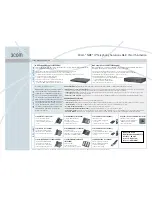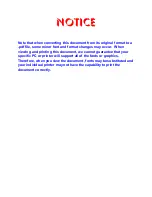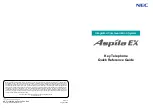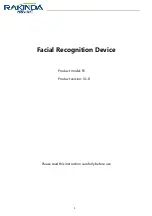
Flexible buttons on the hotel operator’s extension can be set as Room Status Control buttons. The 3 types of
Room Status Control buttons are as follows:
•
Check-in
Switches the status of selected room extensions from Check-out to Check-in.
Remote Extension Dial Lock is turned off, allowing calls to be made from the extension.
•
Check-out
Switches the status of selected room extensions from Check-in to Check-out.
Room extension data, such as Timed Reminder or Last Number Redial data, is cleared, and Remote
Extension Dial Lock is turned on, restricting some calls. This can be useful to prevent the room extension
from being used when no guest is checked in.
•
Cleaned-up (KX-TDA50/KX-TDA100/KX-TDA200 only)
Switches the status of selected room extensions between Ready and Not Ready.
When a guest checks out of a room, the room status becomes Checked-out and Not Ready. After the room
has been cleaned, the status can be changed to Checked-out and Ready using this button. It is also
possible to change the status back to Checked-out and Not Ready if necessary.
Room Status Control Mode
Pressing a Room Status Control button when the PT is idle allows the hotel operator extension to enter Room
Status Control mode. When in Room Status Control mode, the corresponding Room Status Control button’s
light flashes red. The Room Status Control button that was pressed determines which room status each room
extension can be switched to. For example, if the Check-in button was pressed, the Check-in button’s light
flashes red and the hotel operator can select which room extensions to check-in.
In addition, DSS buttons on the hotel operator’s extension or a paired DSS Console show the room status of
each extension as follows:
Light Pattern
Status
Off
Checked-out and Ready
Flashing Red
Checked-out and Not Ready
Red on
Checked-in
[Example Use: Checked-in Mode]
Room101
DSS button
Room102
Room103
Room104
Room105
Check-in button
Check-out button
Rooms 101 and 103
are currently in
checked-in status.
Cleaned-up button
When in Room Status Control mode, the hotel operator’s extension is treated as a busy extension, similar to
when performing PT programming. Callers to that extension will hear a busy tone.
All other operations, including pressing other Room Status Control buttons, will be ignored. In addition, the
lights of fixed and flexible buttons do not show their normal display pattern. In order to perform other operations,
the hotel operator must exit Room Status Control mode.
Document Version 2010-11
Feature Manual
283
15.1.3 Room Status Control
Summary of Contents for KX-TDA50
Page 12: ...12 Feature Manual Document Version 2010 11 Table of Contents...
Page 13: ...Section 1 Features and Configurations A Document Version 2010 11 Feature Manual 13...
Page 26: ...26 Feature Manual Document Version 2010 11 1 1 7 Automatic Time Adjustment...
Page 27: ...Section 2 Features and Configurations B Document Version 2010 11 Feature Manual 27...
Page 30: ...30 Feature Manual Document Version 2010 11 2 1 1 BGM Background Music...
Page 31: ...Section 3 Features and Configurations C Document Version 2010 11 Feature Manual 31...
Page 68: ...68 Feature Manual Document Version 2010 11 3 1 22 CTI Computer Telephony Integration...
Page 69: ...Section 4 Features and Configurations D Document Version 2010 11 Feature Manual 69...
Page 92: ...92 Feature Manual Document Version 2010 11 4 1 11 Doorphone Call...
Page 93: ...Section 5 Features and Configurations E Document Version 2010 11 Feature Manual 93...
Page 104: ...7 7 5 5 External Sensor 104 Feature Manual Document Version 2010 11 5 1 9 External Sensor...
Page 105: ...Section 6 Features and Configurations F Document Version 2010 11 Feature Manual 105...
Page 126: ...126 Feature Manual Document Version 2010 11 6 1 7 FWD DND Button Group FWD Button...
Page 127: ...Section 7 Features and Configurations G Document Version 2010 11 Feature Manual 127...
Page 132: ...132 Feature Manual Document Version 2010 11 7 1 1 GROUP FEATURES...
Page 133: ...Section 8 Features and Configurations H Document Version 2010 11 Feature Manual 133...
Page 140: ...140 Feature Manual Document Version 2010 11 8 1 6 Hot Line...
Page 141: ...Section 9 Features and Configurations I Document Version 2010 11 Feature Manual 141...
Page 177: ...Section 10 Features and Configurations L Document Version 2010 11 Feature Manual 177...
Page 185: ...Section 11 Features and Configurations M Document Version 2010 11 Feature Manual 185...
Page 195: ...Section 12 Features and Configurations O Document Version 2010 11 Feature Manual 195...
Page 202: ...202 Feature Manual Document Version 2010 11 12 1 5 Operator Features...
Page 203: ...Section 13 Features and Configurations P Document Version 2010 11 Feature Manual 203...
Page 275: ...Section 14 Features and Configurations Q Document Version 2010 11 Feature Manual 275...
Page 278: ...278 Feature Manual Document Version 2010 11 14 1 2 Quick Setup...
Page 279: ...Section 15 Features and Configurations R Document Version 2010 11 Feature Manual 279...
Page 285: ...Section 16 Features and Configurations S Document Version 2010 11 Feature Manual 285...
Page 303: ...Section 17 Features and Configurations T Document Version 2010 11 Feature Manual 303...
Page 324: ...324 Feature Manual Document Version 2010 11 17 1 6 TRS Toll Restriction...
Page 325: ...Section 18 Features and Configurations U Document Version 2010 11 Feature Manual 325...
Page 327: ...Section 19 Features and Configurations V Document Version 2010 11 Feature Manual 327...
Page 348: ...348 Feature Manual Document Version 2010 11 19 1 5 Voice Mail DTMF Integration...
Page 349: ...Section 20 Features and Configurations W Document Version 2010 11 Feature Manual 349...
Page 356: ...356 Feature Manual Document Version 2010 11 20 1 4 Wireless XDP Parallel Mode...
Page 357: ...Section 21 Appendix Document Version 2010 11 Feature Manual 357...
Page 377: ...Index Document Version 2010 11 Feature Manual 377...
Page 383: ...Document Version 2010 11 Feature Manual 383 Notes...
















































